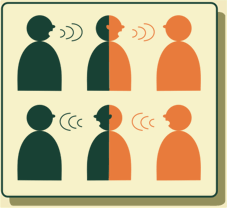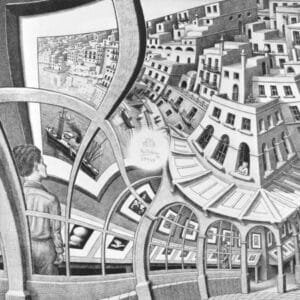It is all fine and dandy when you want to read Tarot cards for someone else. But when you want to do a Tarot card reading for yourself, suddenly, there are a whole bunch of reactions: you are scared, you find that you are drawing a blank, somehow you feel as if you just can’t do it. Trust me, I’ve been there too! However, with a bit of work and some practice it is possible to read Tarot cards for yourself.
Read on to learn about a few simple techniques that can help you to do just that.
Reading Tarot Cards For Yourself: Why Is It So Darned Difficult?
Before we get on to the ‘how’ part, it is very important to understand the ‘why’ part of this scenario.
 The way I see it, as Tarot card readers, we are performing the role of interpreters. We see what the cards are trying to say through the pictures, we get these strange ‘feelings’ or ‘intuitions’ that are often sparked by these images and then we end up saying this stuff to the client. As interpreters, therefore, the major involvement we have is in the process of translating all these various ‘messages’ into words that are spoken aloud.
The way I see it, as Tarot card readers, we are performing the role of interpreters. We see what the cards are trying to say through the pictures, we get these strange ‘feelings’ or ‘intuitions’ that are often sparked by these images and then we end up saying this stuff to the client. As interpreters, therefore, the major involvement we have is in the process of translating all these various ‘messages’ into words that are spoken aloud.
When we read for other people, we are therefore, not vested into the outcome of the reading. Nor are we involved in the actual ‘story’ of what the reading is about. We are just saying what we ‘get’.
But, when we read for ourselves, we are not only involved with the day-to-day events of our life, but we are also vested in the outcome of the reading (what the cards say will happen the future, for example). Thus, we are way too much involved into the reading and its contents and its results.
 Think of it as being in the picture and trying to see that picture, at the same time. Sounds like a Zen Koan doesn’t it? 🙂
Think of it as being in the picture and trying to see that picture, at the same time. Sounds like a Zen Koan doesn’t it? 🙂
We are so involved into the reading that we might want to see a particular outcome, or solution for our current problems. Or we might want to see a certain type of scenario unfold in the near future. But when the reading says something else altogether, or totally doesn’t talk about our question, then we get frustrated. And the temptation is: to just shuffle the cards all over again, and lay out a brand new spread altogether.
So How Do You Overcome This?
Having understood the problem (the ‘why’ part) it is thus easy to derive a solution for it (the ‘how’ part). The problem is the involvement – and the solution is distancing ourselves from the reading.
How does one detach oneself from oneself? How does one look at the picture, while still being in the picture? There are some simple techniques that I have used in order to be able to do that.
Method # 1 : Tell Yourself
 Before doing a reading, I generally meditate for a minute or so and center myself. It is during that time, I tell myself that I am going to be doing a reading for myself and that I should be objective and rational and detached about it. I say this to myself very firmly. I tell myself that even if I don’t like what I see, or I don’t see what I want to see, I need to pay attention to what the cards are telling me. If a particular question has not been addressed, then I can still do another spread for it.
Before doing a reading, I generally meditate for a minute or so and center myself. It is during that time, I tell myself that I am going to be doing a reading for myself and that I should be objective and rational and detached about it. I say this to myself very firmly. I tell myself that even if I don’t like what I see, or I don’t see what I want to see, I need to pay attention to what the cards are telling me. If a particular question has not been addressed, then I can still do another spread for it.
This technique has worked for me all the time. Telling myself all these things has helped me remain detached from the reading and from the outcome of the reading.
It is not an easy method, but it has worked in the long term.
Method # 2 : Use a Substitute for Yourself
 If the first method sounds a bit too difficult, (and at first, it just might), then this method works the best. In this method you use a substitute for yourself. This substitute could be any inanimate object like a pillow or a soft toy – anything that you can keep in front of you, in the place where your client would normally be sitting.
If the first method sounds a bit too difficult, (and at first, it just might), then this method works the best. In this method you use a substitute for yourself. This substitute could be any inanimate object like a pillow or a soft toy – anything that you can keep in front of you, in the place where your client would normally be sitting.
Then during your pre-reading meditation, tell yourself that that pillow or soft toy is you and that you are going to do a reading for that person.
In short, you are practicing for getting yourself psyched up enough to be able to use the first method for doing readings for yourself.
Method # 3 : Say It Aloud
 You can use this method in combination with either of the methods mentioned above. While you are doing the reading for yourself, just say the stuff out aloud. Just like you would when you are doing a reading for someone else. This gets you focused on being the ‘interpreter’ and not the ‘interpretee’ (if such a word even exists)… but you get the drift, right?
You can use this method in combination with either of the methods mentioned above. While you are doing the reading for yourself, just say the stuff out aloud. Just like you would when you are doing a reading for someone else. This gets you focused on being the ‘interpreter’ and not the ‘interpretee’ (if such a word even exists)… but you get the drift, right?
When you read for yourself silently, you are often just internalizing what you see and ‘get’. But saying the stuff out loud, you are putting it out there and that somehow makes a big difference.
No matter which method you use / prefer, the idea is to detach yourself from both, the outcome of the reading and from being too involved in what the cards are saying. Your involvement often acts as a barrier for doing a reading in a detached manner. And these techniques will help you find that detachment – or at least make the process a bit easier.
Seeing Yourself From A Third Person Point of View
Looking at yourself from a third person point of view is not always easy, but once you start doing that, then many things in life take on a very new meaning.
Believe me, this experience changed the way I saw myself completely.
When I started to learn how to read tarot cards, my whole intention was to read for myself (and save myself the money I spent on getting the readings from someone else)! But, when I, as a Tarot card reader sat down to read for myself, I found myself caught up in the same place as most everyone else. For some time, I simply drew blanks – my mind would refuse to function and the cards seemed like strangers. When I psyched myself to read for myself, it was very tough going for me at the start. But the combination of the different methods mentioned above really worked for me. And over a period of time, reading for myself became fairly easy.
Looking at myself from a third person point of view also helped me see things more clearly. This point of view helped me take decisions in life which were more rational / sane / objective, rather than emotional and helped me find balance and center in my life.
Your Turn
So, what have your experiences been about this? Do you read for yourself? Have you tried reading for yourself? Have you used any of the methods mentioned above? Or do you have any other method that works?
Please share your thoughts and ideas in the comments below.


I sometimes have difficulty reading for myself too, but only because I
have trouble being objective when it comes to my own issues. One way
that I have found around this is to do a spread (whichever one is
applicable), write down all the placements and set it aside for an
hour or so. I then go back and read what’s there where I don’t have as
much emotion invested, with “fresh eyes” so to speak. I’ve found that
this seems to work best for me, especially if the cards are indicating
something other than what I want to see!
Hey Melissa,
That’s a great way to literally ‘put some distance’ between you and the reading!
Thanks for sharing! 🙂
M
Despite years of practice I have found that my usual description of a Tarot reading I do for myself is “A combination of the bleeding obvious and the incomprehensible” – too often it tells me what I already know, then hints at some things that I just can’t get my head around.
I have, however, found that one of the methods you outline works well for me – that is, talking through the reading out loud. If I read for a client I take my time, explain things, give examples and metaphors to ensure they really understand what I’m trying to convey to them. However, when I read for myself I have a bad habit of looking at the cards and going ‘yup, know what that is, know what is, know what that is… what the hell does that mean?’ and then moving on. Whilst I’d take 15 minutes on a reading with a client I may only take a few minutes to read over a spread for myself. Slowing down *really* helps – and speaking out loud, forcing myself to verbalise all of my thoughts, forces me to slow down and take a little longer to think about things.
However, there is one problem I fear there may be no way to overcome – sometimes a reading is telling us something that is just outside of our normal emotional spectrum. It is ‘beyond’ where we are in life, beyond our ability to comprehend at this exact moment… in simplest form it is an idea that we haven’t had yet. And that’s why a reader can be so helpful – through intuition or a moment of insight they can tell us something new, introduce a new piece of vocabulary, a new shape for our minds, a new image to work with… and that can start moving us forward.
So for me – reading for myself is hard, but better if I slow down, but I’m never going to dispense with the services of other readers.
Hi James,
I like your description of a reading that one has done for oneself: “a combination of the bleeding obvious and the incomprehensible” 🙂
The talking out loud method was what got me going when I started out reading for myself too! It works like a charm! And yes, I too have gone through the ‘yup, know what that is, know what is, know what that is… what the hell does that mean?’ process (I can so relate to your description!) – which is probably why reading out aloud makes more sense – because it forces us to stop this internal dialogue and say the stuff out loud…thus forcing us to do the reading, rather than just skip over the parts we think we know about.
These cards can seem confusing like that – especially when they are trying to tell us something they haven’t before, and coincidentally it happens when we are reading for ourselves. When it happens while doing a reading for someone else, we are in a flow, and since we are reading for someone else, we aren’t involved so personally – and those times, we get the “Aha!” moments much easier…
Here’s what I do when I do encounter a card a card that just doesn’t make any sense (at that point, anyhow) – I write it down in my Journal (the card, and the placement in the spread) so I don’t forget about it. The card then remains at the back of my mind, and then somewhere down the line, a few days later, the whole point of the card just pops into my head like an “Aha!” moment.
And at other times, I too consult another reader – these are those times when one is too close to the issue to really be detached enough for a reading. So yes, there is no point in dispensing with the services of other readers! 🙂
Thanks so much for sharing your thoughts with me!
Madhavi